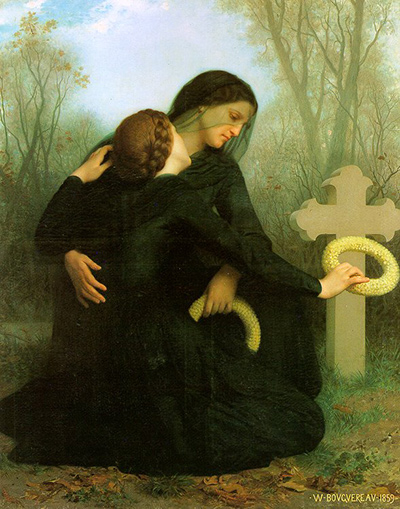All Saints Day (known in French as Le Jour Des Morts) is a painting in oil on canvas by the French artist William Bouguereau (1825-1905). He created several versions of the work, which attracted considerable critical acclaim.
It has been included in surveys of the sources of Impressionism for the misty, slightly otherworldly nature of its design, especially the trees seen in the background.
The first version of All Saints Day to come to public notice went on display in 1859. Bouguereau was still relatively unknown at this point, so his participation in the Paris Salon that year represented a tremendous opportunity. The exhibition, held at the Palais des Champs-Elysées, featured almost 4,000 works and is considered one of the landmark events in the mid-19th-century French art world. Bouguereau's painting received a warm reception: leading critic Paul de Saint-Victor described it as "elegantly and poignantly rendered".
The painting depicts a pair of women in formal mourning dress kneeling at a grave in a quiet churchyard and comforting each other in their bereavement. Both women are holding woven rings, intending to place them on the grave. The pose of the two women is similar to that in elegiac classical works by the likes of Bion, and except for the clothing is reminiscent of tragic Greek scenes at tombs.
The Musée des Beaux-Arts in Bordeaux, noting the positive reception to Bouguereau's work, immediately purchased it; the painting remains in the same ownership today, although it is frequently seen on loan to other galleries around the world.
Bougereau also produced a number of much smaller versions of All Saints Day, and these too became highly sought after – an 1864 example measuring 61 by 51 cm sold for $240,000 in 2004. It is not certain why the artist produced these replicas: some were produced to be reproduced as engravings, but some were painted considerably later and may have been modelled on sketches rather than the original, larger canvas.




